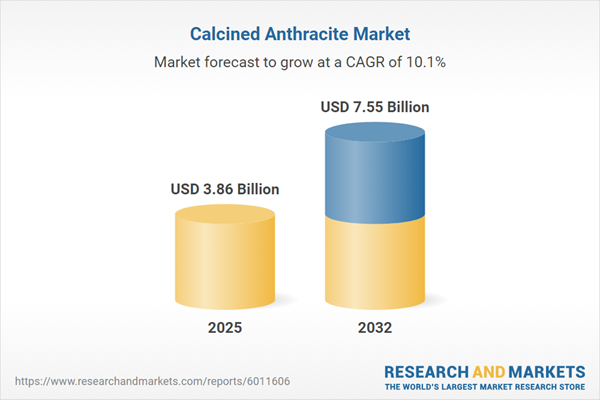Speak directly to the analyst to clarify any post sales queries you may have.
Calcined anthracite is emerging as a strategic resource for senior executives focused on strengthening operational resilience and adapting to shifting industrial demands. Its reliability and consistency have established it as a cornerstone of process efficiency in multiple sectors navigating regulatory complexity, procurement challenges, and the pursuit of optimized carbon management.
Market Snapshot: Calcined Anthracite Market Size, Growth, and Driving Forces
The global calcined anthracite market is experiencing pronounced growth, with value rising from USD 3.50 billion in 2024 to USD 3.86 billion projected for 2025, demonstrating a compound annual growth rate (CAGR) of 10.09%. This advancement is underpinned by sustained demand in critical industries that require high-purity carbon inputs, especially steel, foundry, and refractory manufacturing. In parallel, investments in advanced processing methods, streamlined procurement strategies, and organizational agility to evolving standards are solidifying calcined anthracite’s integral role in international supply networks and industrial applications.
Scope & Segmentation: Core Market Axes
- Application Areas: Enables stable operations in ferroalloy production, foundry casting, refractory brick formulation, castable mortars, and both blast and electric arc furnace steel manufacturing, delivering process reliability and consistent quality.
- Grade Types: Presents procurement teams with high, medium, and low grade options to match specific quality and cost profiles, supporting versatility across production segments.
- Production Processes: Utilizes technologies such as multiple hearth furnaces, static kilns, rotary kilns, and moving shaft kilns, allowing for adaptation of product properties to specific industrial end-uses.
- Physical Form: Offers granules, lumps, or powder to support integration with diverse manufacturing methods and simplify logistical planning and storage.
- Carbon Content Range: Supplies below 90 percent, 90–95 percent, and above 95 percent carbon content to meet both generalized and highly specialized usage in sectors such as steelmaking and refractory production.
- Regional Markets: Addresses unique supply chain demands and regulatory conditions in regions including the Americas (United States, Canada, Brazil), European Union (Germany, France, Russia), Middle East (UAE, Saudi Arabia), Africa (South Africa, Egypt), and Asia-Pacific (China, India, Japan), each requiring tailored approaches.
- Leading Companies: Involves established players like Asbury Carbon, Black Diamond (Clarus Corporation), Dev Technofab Ltd., Elkem ASA (Orkla ASA), Headwin Exim Private Limited, Henan Star Metallurgy Material Co.Ltd, Jh Carbon Pty Ltd, Kingstone Group, Resorbent s.r.o., and Rheinfelden Carbon Products GmbH, all contributing distinct strategies as the market develops.
Key Takeaways: Insights for Senior Decision-Makers
- Consistent quality in calcined anthracite is vital to operational performance, particularly in applications where uptime and strict compliance standards are mission-critical.
- Digital traceability and real-time monitoring systems increase responsiveness to regulatory shifts and help reduce the risk of unplanned downtime, offering clarity for compliance management.
- Strengthening supplier diversification strategies supports organizational resilience and enables swift adjustment to potential supply chain disruptions or evolving sourcing needs.
- Manufacturers benefit from a broad spectrum of grades and carbon content, facilitating fine-tuned product performance while allowing rapid adaptation to changing regulatory and production requirements.
- Ongoing investments in infrastructure across key emerging regions drive opportunities for supplier–buyer partnerships, supporting the development of tailored, localized solutions that meet near-term business priorities.
Tariff Impact: U.S. Tariff Changes and Strategic Response
Recent tariff modifications in the United States have prompted industrial organizations to reassess procurement frameworks, placing greater emphasis on diversified global sourcing channels and deepening international supplier partnerships. Many companies are strengthening domestic capacity and reviewing alternative energy options, which reinforces operational reliability in the face of changing trade and market conditions.
Methodology & Data Sources
This evaluation combines insights from in-depth interviews with decision-makers in metallurgy, refractory production, and supply chain management. All findings related to regulatory and operational strategies have been peer-reviewed, ensuring leaders receive well-substantiated, actionable guidance.
Calcined Anthracite Market: Why This Report Matters
- Enables executives to clearly identify new business opportunities and refine organizational tactics in response to ongoing trends affecting calcined anthracite applications and procurement.
- Enhances visibility into critical production, sourcing, and regulatory factors influencing strategic planning and procurement decision-making.
- Supports investment planning and helps refine supplier management strategies to build more resilient operations in an evolving market landscape.
Conclusion
Calcined anthracite is fundamental for maintaining manufacturing continuity and resilient supply chain operations. This report offers evidence-based analysis, empowering senior leaders to confidently navigate regulatory, sourcing, and technology complexities worldwide.
Additional Product Information:
- Purchase of this report includes 1 year online access with quarterly updates.
- This report can be updated on request. Please contact our Customer Experience team using the Ask a Question widget on our website.
Table of Contents
3. Executive Summary
4. Market Overview
7. Cumulative Impact of Artificial Intelligence 2025
Companies Mentioned
The companies profiled in this Calcined Anthracite market report include:- Asbury Carbon
- Black Diamond (Clarus Corporation)
- Dev Technofab Ltd.
- Elkem ASA (Orkla ASA)
- Headwin Exim Private Limited
- Henan Star Metallurgy Material Co.Ltd
- Jh Carbon Pty Ltd
- Kingstone Group
- Resorbent s.r.o.
- Rheinfelden Carbon Products GmbH
Table Information
| Report Attribute | Details |
|---|---|
| No. of Pages | 191 |
| Published | November 2025 |
| Forecast Period | 2025 - 2032 |
| Estimated Market Value ( USD | $ 3.86 Billion |
| Forecasted Market Value ( USD | $ 7.55 Billion |
| Compound Annual Growth Rate | 10.0% |
| Regions Covered | Global |
| No. of Companies Mentioned | 11 |









